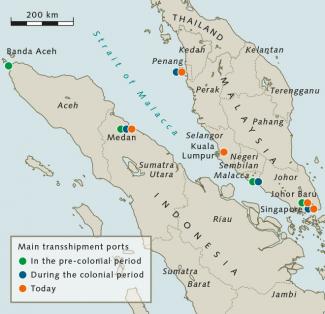Marine Electronic Highway: Towards A Novel Management of Straits of Malacca and Singapore
The Straits of Malacca and the Straits of Singapore are not only critical for the economic vitality of Southeast Asian states but are crucial for global trade and commerce. Being congested and confined sea-lanes, the safety of maritime traffic is threatened from at least three directions. These are (a) poor navigation system (b) Pollution from the sea traffic and (c) Maritime security. These are closely related to each other. As regards to navigational safety, the Straits are shallow and have several wrecks that make navigation a very difficult task. The quality and operational availability of navigational aids have also been a cause of concern. This contributes to accidents leading to collision, grounding or sinking of ships. Tanker accidents are the most dramatic sources of oil pollution. Besides, some ships routinely discharge bilge water, oil tanks and cleanse ballast. Some even dump waste onto the sea further adding to pollution. The maritime security issues related to drug trafficking, human smuggling, arms trafficking, piracy and terrorism. These limitations and vulnerabilities have the capacity and capability to threaten the peaceful use of the straits and the safe regulation of global trade.
In a technology-driven world, there is a need to harness tools of information technology (IT) to further add to the safety and security of the Straits. Currently, some security systems are in place to manage the Straits of Malacca and the Straits of Singapore. These include the Malaysian Sea Surveillance System, Malaysian Vessel Traffic System, Mandatory Ship Reporting System, Tri-lateral Coordinated Maritime Patrols by Malaysia, Singapore and Indonesia, International Maritime Bureau (IMB) Piracy Reporting Center located at Kuala Lumpur and a host of other surveillance and monitoring systems along the coast of the littoral countries. These systems generate data such as radar video, vessel location, movement, identity, cargo, ports of call, and other data relating to vessel traffic, distress management, piracy reporting and pollution monitoring information. These systems can be further integrated to provide a more useful and comprehensive common picture for situational awareness. This will add to a more effective network to facilitate more efficient information and intelligence sharing within the context of what is today called Total Maritime Domain Awareness.
At the same time, the shipping industry too is gearing up to meet the new requirements of IT managed maritime affairs. The ship navigation charts are being digitalized to add to accuracy as well as integrate with host of new IT-driven navigational support infrastructure. The newer merchant vessels are equipped with electronic navigational charts (ENCs), electronic chart display and information systems (ECDIS) including an integrated control system for the ship. Besides, there is the Differential Global Positioning System (DGPS) with an accuracy of 1 to 5 meters that enhances the navigational accuracy of ENCs-ECDIS, especially in congested and confined waters. However, the majority of the present world fleet still uses paper charts for navigation. The slow adoption of new technologies by the shipping industry is due to several factors such as capital outlay requirement, training of mariners and limited sea area coverage of current ENCs.
Meanwhile the International Maritime Organisation, in its visionary wisdom, conceptualized the Marine Electronic Highway (MEH) to provide opportunities and benefits not only for the shipping industry but also to a variety of users. The World Bank approved, in principle necessary financial resources and a Letter of Agreement was signed on March 12, 2001, between the World Bank and IMO to implement the grant. The first MEH Project Steering Committee Meeting was held in Putrajaya, Malaysia in March 2001.
The IMO is now planning to convene a high-level conference on MEH during July 2005. An IMO statement has noted that: “The Council also urged the Organization and the Secretary-General, in cooperation with the littoral States concerned, to continue their efforts to enhance safety, security and environmental protection in the Strait of Malacca to ensure that the Strait continues to remain safe, secure and open to international navigation, through awareness-increasing; information sharing; personnel training; capacity-building; and technical cooperation. In seeking the attainment of these objectives, the intention will also be to promote the IMO's visionary Marine Electronic Highway project and to seek advice from the participants on how to configure it in a manner that can best serve the cause of maritime security in addition to its original goals of enhancing safety and environmental protection in the Straits.”
The MEH will be a network of ENCs using ECDIS, environmental management systems, automatic ship identification (AIS) transponders as also meteorological, oceanographic and navigational information. The network may be expanded to include search-and-rescue operations, anti-piracy programme, environmental impact assessment, and fisheries/aquaculture management. The implementation of the MEH Project and the lessons to be learned will thus be much anticipated not only by the littoral states but also by the international maritime community.
